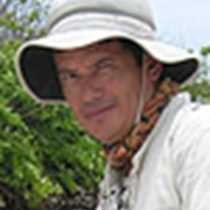Española Island
Today we visited the oldest island of the archipelago. It was approximately five million years ago that the top of a submarine volcano breached the Pacific Ocean to become one of the first Galápagos islands. This volcano increased its altitude and the size of the new island with all the material of thousands of years of eruptions. But the island gradually moved away from the active hotspot that gave rise to it and the volcano became extinct; in other words, this island is dying. Of course, I am talking as a geologist, but from the point of view of a naturalist this place is really incredible and full of life.
In the morning we landed at Punta Suarez at the western-most position of Española; this island doesn’t have highlands, but it is the place where many species of sea birds and reptiles inhabit. This morning was perfect for us because it was very cloudy with some garua which was a blessing for land life. Everywhere, finches and mockingbirds flutter around the bushes drinking fresh water collected on leaves of bushes, while on the rocks the marine iguanas piled like grapes waiting for the sun’s energy, kept warmer with their bodies’ heat.
On the beach, a big sea lion swims back and forth patrolling its territory. Furthermore, a group of sea lion pups nurse at the beach. Walking along the trail, we arrived to the waved albatross’s territory; a group of them flying and other nesting or feeding chicks; the most incredible moment was when a huge albatross landed, running several feet before stopping; then we understood Española is like an airport for them.
In the afternoon we landed at Gardner Bay, but a group of our guests began their activities with kayaking or with the glass bottom boat. We couldn’t resist getting in the water and exploring the underwater world, enjoying our time with many different types of fish and playing with some sea lions. On the beach we swam with our guests from the beach and around the rock in front of it.
At the end of this beautiful day, it was very cold and we came back to the National Geographic Endeavour, our home during this amazing week.




